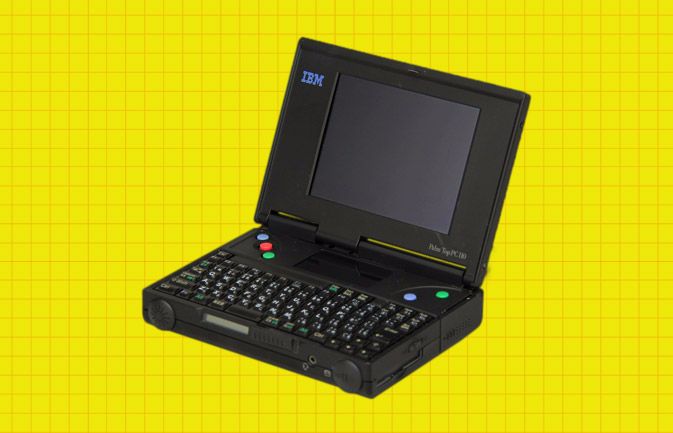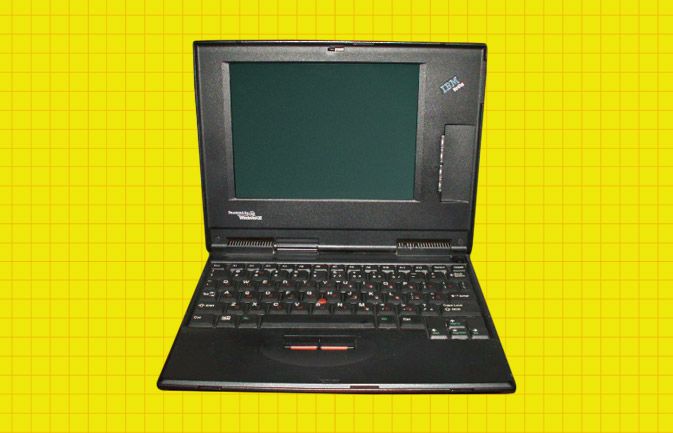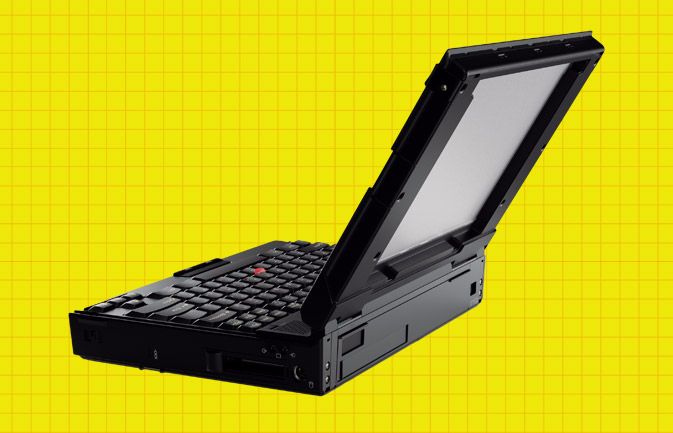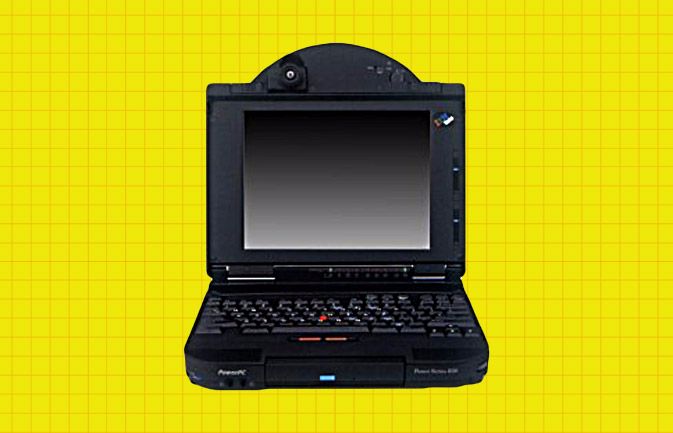25 Years of ThinkPad: The Best and Most Innovative
Since 1992, the ThinkPad brand has been synonymous with strong build quality, eye-popping innovations and first-class usability. In the past 25 years, IBM and later Lenovo have released hundreds of different ThinkPad models and sold over 100 million units. Though all of these laptops share a common design language and heritage, several models standout for their unique features. These are the 25 best and most interesting ThinkPads of the past 25 years.

ThinkPad X300 (2008)
The first laptop that was developed exclusively after Lenovo bought the brand, 2008's ThinkPad X300 is one of the best laptops ever made by any brand. Though it came out around the same time as Apple's first MacBook Air, the groundbreakingly-thin and light X300 has serious-productivity features such as a high-res (for the time) screen, a fingerprint reader and a speedy SSD. It even came with a built-in DVD-R drive, which you could replace with a second battery. Perhaps the best thing about the ThinkPad X300, however, was a luxurious soft-touch texture on that made it feel like you were using a gel wrist rest while you type on the fantastic 7-row keyboard. At 3.3 pounds, which is even light by today's standards, the laptop was also a joy to carry and place on your lap. David Hill, who served as the head ThinkPad Designer for 25 years, told us that the X300 is one of his favorite laptops of all-time. "[This is] the first ThinkPad that was made under the umbrella of Lenovo and, at the time there was a lot of angst that this jewel of ThinkPad was going to be ruined. We really set off on a mission to create the best ThinkPad ever made and this was important to us both from a business perspective and from a design and engineering perspective," he said.

ThinkPad 701C (1995)
In order to fit a reasonably wide keyboard on a laptop with a narrow, 10.4-inch screen, IBM came up with an innovation so bold and attractive that landed this laptop in New York's Museum of Modern Art. The ThinkPad 701C is the only laptop ever made with a "butterfly" keyboard that folds out over the deck as you open the lid. "It was so unexpected and James Bond-like," Hill said. "You expect Q to pull this thing out." Hilltold us that he attempted to bring the butterfly keyboard back for other small ThinkPadsover the years, but was never able to get one into a production model again. Unfortunately, as laptops and their screens have gotten wider, the need for a fold-out keyboard has also disappeared.

ThinkPad TransNote (2001)
Even in 2017, it's difficult to find a digital pen that feels as good as writing with ink on paper. In 2001, IBM had this problem licked with the TransNote, which featured both a laptop and a standard 8.5 x 11-inch paper notepad stacked next to each other in a portfolio. The included digital pen would automatically transfer whatever you scribbled onto your laptop, giving you the best of both digital and print writing. The laptop portion of the TransNote was an impressive device in its own right with a screen that popped up and swiveled around so you could use it in either standard or presentation modes. “I still think the idea of note-taking and annotating documents with handwriting or sketching and drawing is a big deal," Hill said. "When you do draw on paper, it’s extremely natural."

ThinkPad 550BJ (1993)
Made for a very limited run in Japan, the ThinkPad 550BJ featured a built-in Canon bubblejet printer. You just fed the paper in through a slot under the keyboard and watched as it came out the back. The 550BJ had a 486 CPU and a 9.5-inch display that only output in monochrome.

ThinkPad W700ds (2008)
Having multiple screens makes you more productive when you're at your desk, but what happens when you need to take your laptop somewhere else? Released in 2008, the ThinkPad W700ds offered a second, 7-inch display that popped out of the right side of the lid so you could. For example, you could keep your instant messenger feed visible while you edited a spreadsheet on the 17-inch main screen. Unfortunately, the dual-screen idea fell by the wayside, perhaps because the 11-pound, 2.1-inch thick laptop was way too bulky. David Hill described the W700ds as "the laptop that needed its own airplane seat."

IBM PC110 (1995)
The smallest ThinkPad ever made and, by far, one of the most unique is IBM's PC110. The 1.3-pound device was only a little larger than an Nintendo 3DS, but packed a 4.7-inch VGA screen, an Intel 486SX processor, up to 8MB of RAM and up to a 260MB hard drive. The tiny laptop, which ran DOS as its preloaded OS, found room for plenty of ports, including VGA-out, a 2,400 baud modem, a headphone jack and a parallel port for printing. The keys on the keyboard were predictably small and the TrackPoint was oddly located in the upper left corner of the deck. No matter what you think of its usability, the PC110 was a triumph in miniaturization.
Sign up to receive The Snapshot, a free special dispatch from Laptop Mag, in your inbox.

ThinkPad 700C (1992)
The very first ThinkPad laptop launched on October 5, 1992 and the world was never the same. This 8-pound laptop was designed to look like a bento box, with its black, rectangular design language. It also introduced the iconic TrackPoint pointing stick, which still appears on most ThinkPads today. The ThinkPad 700C had high-end specs for its day, including a 10.4-inch, 640 x 480 display, a 25-MHz 486 CPU and up to 8MB of RAM. It was the first laptop with a TFT (thin film transistor) display, the same technology we stillsee on most LCD panels.

ThinkPad X41 Tablet (2005)
Today, most 2-in-1s have screens that either bend back 360 degrees or detach to turn into standalone slates. However, back in 2005, the ThinkPad X41 innovated by offering a lid that swivels around 180 degrees and snapped back to go into tablet mode. Many subsequent ThinkPads used the same swivel hinge until the company introduced its bendback Yoga concept just a few years ago.

ThinkPad Edge 13 (2010)
Though the classic ThinkPad color is raven black, a few models buck that trend by offering other shades. Launched in 2010, the ThinkPad Edge 13 was available with a glossy, fire engine red lid as well as more traditional matte black and glossy black colors. The sides of the Edge 13 also has a unique silver trim. In its biggest break from ThinkPad tradition, the Edge 13 was the first ThinkPad to feature an island-style keyboard, a standard that later reached every laptop in the lineup.

ThinkPad X1 (2011)
After Lenovo discontinued the groundbreaking X300 series (X300 and X301), the company replaced its 13-inch flagship with the ThinkPad X1. This 2011-era laptop stands out as one of the first to use an island-style keyboard, but despite the change in design, its keys offered some of snappiest feedback we've ever experienced on a laptop. While Lenovo doesn't normally give specific drop heights for its laptops, the company designed the X1 to survive 5.2-foot falls.

ThinkPad Helix (2013)
With the noteworthy exception of the Microsoft Surface Book, most detachable 2-in-1s have flimsy keyboards with few extras in the base. However, a couple of years before Microsoft launched its powerful product, Lenovo's ThinkPad Helix was the ultimate detachable. The 11.6-inch Helix offered strong specs such as a Core i5 or i7 CPU and a speedy SSD, along with a vibrant 1080p display. However, the real star of the show was its included keyboard dock, which featured a second battery for longer endurance and some cooling fans. Best of all, you could mount the screen facing backwards in order to use the Helix in presentation mode.

ThinkPad X220 (2011)
Today's longest-lasting laptop is the ThinkPad T470, which endured for over 17 hours on our battery test (continuous surfing over-Wi-Fi). However, 2011's ThinkPad X220 beats the pants off of every current laptop; it tapped out after a whopping 20 hours and 18 minutes. The 12.5-inch laptop was able to last so long on a charge because of its optional 9-cell battery and bottom-mounted battery slice. In subsequent years, Lenovo stopped offering battery slices, capping the maximum amount of juice you could attach to a laptop.

Lenovo ThinkPad Yoga S1 (2013)
Debuting in 2013, the ThinkPad Yoga S1 was the first Lenovo business notebook to feature the company's groundbreaking bend-back design. The 12.5-inch 2-in-1 was also the first notebook of any kind with a "Lift n' Lock" keyboard, which has keys that retract when you bend the lid back. The Yoga S1 also features an active stylus and over 8 hours of battery life.

ThinkPad 13 (1st Gen, 2016)
The original ThinkPad 13, which launched in 2016, offered all-time great value while providing the first USB Type-C port on a ThinkPad. Selling for under $650 at the time it came out, the 13-inch, 3.1 pound laptop provides such premium features as a 1080p screen and an SSD. It also lasts over 9 hours on a charge. Available in black or silver, the original ThinkPad 13 also has one of the most responsive ThinkPad keyboards we've ever used. The company refreshed the ThinkPad 13 with a new CPU and several new options, including a touch screen, in 2017. However, the price went way up, making it less of a bargain.

IBM Workpad z50 (1999)
Raise your hand if you remember the Windows CE operating system. Back in 1999, a number of manufacturers, including NEC and HP, released HPCs (handheld PCs) based on this stripped-down, embedded version of Windows. The Workpad z50 was IBM's entry into this short-lived space and, though it wasn't officially labeled as a ThinkPad, it was definitely part of the family. The 8.2-inch laptop weighed a mere 2.65 pounds but provided a good keyboard with the TrackPoint right in the middle. In an age where true SSDs were still years away, the z50 used flash memory and booted or waked from sleep much faster than most hard drive-based laptops. The z50 didn't come with Wi-Fi built-in, but it had a PC card slot where you could attach your own 802.11b card for surfing the web. Unfortunately, the industry gave up on HPCs and Windows CE before the devices like the Workdpad z50 really had a chance to catch on.

ThinkPad T400s (2009)
Lenovo's Thinkpad T series has long provided a strong balance between performance, battery life and versatility. However, up until 2009, ThinkPad Ts were fairly chunky. The T400s changed the trajectory, shrinking the weight by a pound and the thickness by 0.3 inches from the bulkier T400. Lenovo continues to offer both regular and "slim" versions of its T series to this day. In 2017, the ThinkPad T470s is about 0.6 pounds and lighter than the T470.

ThinkPad X1 Yoga (2016, 2017)
The ultimate business 2-in-1, the ThinkPad X1 Yoga combines a lightweight chassis with a gorgeous screen and plenty of ports. However, what really makes the X1 Yoga stand out is an optional OLED display that makes its image output as vibrant as a high-end phone screen. There's only one other laptop with OLED, the Alienware 13. The 2017 version of the X1 Yoga adds a "Wave" keyboard where the keys retract when you bend the lid back into slate mode. The prior model had a "Lift n' Lock" keyboard, which had the keyboard tray rise above the keys to prevent you from pressing them when you're in tablet mode.

Thinkpad 755CDV (1995)
We've seen tiny pico projectors that plug into your laptop and we've seen tablets and phones with built-in projectors, but how would you like a laptop with a screen that turns into a projector. The ThinkPad 755CDV allowed you to remove the back of its display so you could bend it back 180 degrees and strap it to the surface of an overhead projector.

ThinkPad X1 Carbon (2nd Gen, 2014)
Apple made headlines when it introduced the MacBook Touch Bar in 2016, but Lenovo was replacing the function row with a screen way before it was cool. In 2014, the 2nd Generation ThinkPad X1 Carbon was the first to feature an "Adaptive Function Row" which replaced the F1 to F12 keys with a grayscale, e-paper display which could show different symbols based on what app you run. Unfortunately, the Adaptive Row only had four different sets of icons and, because it offered no feedback, it made touch typing on its keys impossible. Lenovo went back to physical function keys on 2015's X1 Carbon, but it had made a lasting mark on the industry.

ThinkPad 570 (2000)
Available with 12.1 or 13.3-inch screens, this svelte (for its time) ThinkPad was the first to offer the Ultrabase, a portable dock that added a slew of ports and an optical disc drive.

ThinkPad Z60m (2005)
For the first half of their history, ThinkPads used 4:3 aspect ratio screens with resolutions such as 640 x 480, 800 x 600 or 1024 x 768. However, Lenovo changed up its screens with 2005's Z60m, which was the first to provide a 16:10 display, which was available in 1280 x 800 or 1680 x 1050 resolutions. This powerful 15.4-inch laptop also came with a Pentium M CPU, up to 1GB of RAM and up to 100GB hard drive, solid specs for the time.

ThinkPad 755CD (1994)
The earliest ThinkPads came with 3.5-inch floppy disk drives for exchanging data, but by 1994, many programs started coming on CD-ROM and IBM had to respond. The ThinkPad 755CD was the first laptop of any kind with a built-in optical drive, allowing you to browse digital encyclopedias or play top-of-the-line games such as Myst. The CD-ROM drive sat in a swappable UltraBay slot so you could remove it and swap in a floppy drive for your set of 15 Windows install disks. The 10.4-inch laptop, which was powered by an Intel 486 or Pentium 75 CPU, had one more cool trick up its sleeve. A pair of ports on the side allowed you to connect to your cable box or VCR in order to do video capture.

ThinkPad 850 (1995)
A fascinating slice of computer history, the ThinkPad 850 was one of a few laptops that used IBM's PowerPC CPU rather than a standard Intel chip. Made through a collaboration between IBM, Apple and Motorola, PowerPC processors could not run standard Windows programs. Instead, the 850 was limited to running a special version of Windows NT Server, which could not use all the same apps, a special version of OS/2 Warp or IBM's old-school AIX operating system. Many Macs used PowerPC chips but in the PC world they never caught on. In addition to its odd CPU platform, the ThinkPad 850 was available with a unique camera accessory that attached to the top of the lid, giving the entire laptop a huge arc-shaped protrusion.

ThinkPad 220 (1993)
A tiny "subnotebook" that was built for the Japanese market, the ThinkPad 220 had a small 7.7-inch, 640 x 480 display and weighed just 2.2 pounds, which is featherweight even by today's standards. Rather than packing the iconic TrackPoint in the middle of its keyboard, the 220 had a bright red trackball located in the upper left corner of its deck. The laptop also used 6 AA batteries. "At that point, TrackPoint hadn’t taken off as part of the brand signature," Hill said.

Combining modern-day performance and features with classic ThinkPad design elements such as a 7-row keyboard, a rainbow logo and a soft-touch deck, the ThinkPad 25 is a fan's dream machine. A modified version of the ThinkPad T470, our favorite business laptop of 2017, the ThinkPad 25 comes decked out with high-end specs such as a Core i7 CPU, a 1080p touch screen, discrete Nvidia 940MX graphics and a 512GB PCIe SSD. Best of all, with its optional 6-cell battery, this laptop lasts over 13 hours on a charge.

